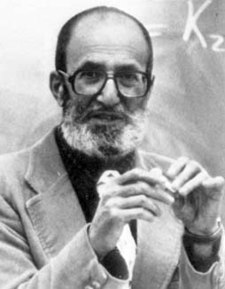Paul Halmos
| Paul Halmos | |
|---|---|
 |
|
| Born |
March 3, 1916 Budapest, Austria-Hungary |
| Died | October 2, 2006 (aged 90) Los Gatos, California, U.S. |
| Nationality | Hungarian American |
| Fields | Mathematics |
| Institutions |
Syracuse University University of Chicago University of Michigan Indiana University Santa Clara University |
| Alma mater |
Institute for Advanced Study University of Illinois |
| Doctoral advisor | Joseph L. Doob |
| Doctoral students |
Errett Bishop H. Arlen Brown Bernard Galler Don Hadwin Eric Nordgren Herman Rubin Donald Sarason V. S. Sunder |
| Notable awards |
Chauvenet Prize (1947) Lester R. Ford Award (1971,1977) Leroy P. Steele Prize (1983) |
Paul Richard Halmos (Hungarian: Halmos Pál; March 3, 1916 – October 2, 2006) was a Hungarian-Jewish-born American mathematician who made fundamental advances in the areas of mathematical logic, probability theory, statistics, operator theory, ergodic theory, and functional analysis (in particular, Hilbert spaces). He was also recognized as a great mathematical expositor.
Halmos arrived in the U.S. at 13 years of age, but never lost his Hungarian accent. Halmos obtained his B.A. from the University of Illinois, majoring in mathematics, but fulfilling the requirements for both a math and philosophy degree. He took only three years to obtain the degree, and was only 19 when he graduated. He then began a Ph.D. in philosophy, still at the Champaign-Urbana campus; but, after failing his masters' oral exams, he shifted to mathematics, graduating in 1938. Joseph L. Doob supervised his dissertation, titled Invariants of Certain Stochastic Transformations: The Mathematical Theory of Gambling Systems.
Shortly after his graduation, Halmos left for the Institute for Advanced Study, lacking both job and grant money. Six months later, he was working under John von Neumann, which proved a decisive experience. While at the Institute, Halmos wrote his first book, Finite Dimensional Vector Spaces, which immediately established his reputation as a fine expositor of mathematics.
Halmos taught at Syracuse University, the University of Chicago (1946–60), the University of Michigan (~1961–67), the University of California at Santa Barbara (1976–78), the University of Hawaii, and Indiana University. From his 1985 retirement from Indiana until his death, he was affiliated with the Mathematics department at Santa Clara University.
...
Wikipedia
